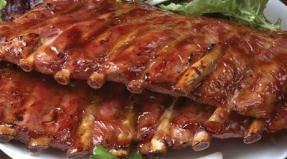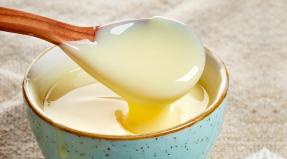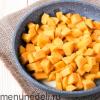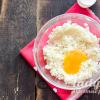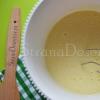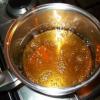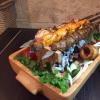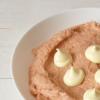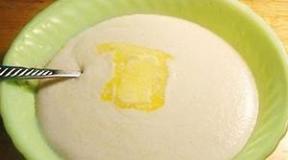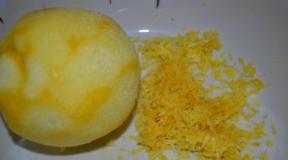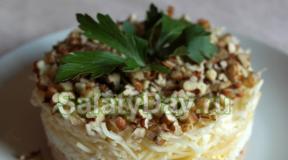What makes carmine make. What influences the organism is the food additive E120 and what harm does it carry? May cause allergic reactions
General characteristics and receipt
Dye E120 has two names, since different insects serve as a source of paint. The carmine worms dwell on trees (for example, oaks), their homeland is the old light. And Koshenivnye prefer to settle on indentation cacti. Paint Koshenil came to us from the American continent. Both types of insects contain one and the same carmine acid. Depending on the level of acidity of the medium, it gives orange, red or purple.
The modern dye market is 95% covered by supplies from Peru, the main source of raw materials is stable Cherwec. The process of obtaining carmine labor-intensive, so the dye is expensive. The beetles are collected during the period when they are preparing for teaching eggs. They are removed from the leaves with a rigid brush, dried and crushed into powder, which is then treated with ammonia solution or sodium carbonate and filtered.
Despite the fact that the dye source is a robust worm, the official name of the product - carmine, which is registered by the name of the organic compound - carminic acid. This dye is resistant to oxidation and high temperatures, does not lose its properties when exposed to light.
Purpose
In ancient times, carmine was intended mainly for staining fabrics and yarn. In addition, he attached a bright color to some cosmetic products, and was also a mandatory component of the palette of artists. The Hermitage is stored a Persian carpet, woven about 2.5 thousand years ago and painted by carminic, and the color is well preserved. In the Middle Ages, the carmic dye was one of the most expensive, dyeers loved him very much for the resistance of the color. But in the paintings of artists, Carmin quickly faded.

Modern main appointment of carmina - food dye. It is added to meat and sausages, fish and some types of cheese, alcoholic and carbonated sweet drinks, sauces and pastry, dry grain breakfasts and fruit canned food.
Impact on the human body: benefit and harm
For the human body, the dye carmine neutral. It does not bring any benefit except the aesthetic pleasure from products, which, due to the presence in their composition, the carmines look more appetizing.

The harm harm is estimated from the point of view of its allergity. There are medical statistics of patient appeals who have developed a strong allergic reaction, up to anaphylactic shock, for products with the addition of carmina. Contact allergies can develop on decorative cosmetics if it contains this dye. Therefore, all over the world, the laws require indicate on the labels of goods, whether in the composition of carmine and in what quantity.
Use and application
Since ancient times, Carmin has been a dye for fabrics and yarn. The mats and elements of the festive clothes of Incs and Aztecs painted by carminic are preserved. Armenian carpets, pillows and wool dress painted by "Kirmome" are mentioned in the Arab books of the X century (this is the Arabic name of Carmina). It was very expensive goods put up for sale. As the dye spreads, it was used in different ways. In the UK they painted cloth for army uniforms. In France, used as a perfume pigment. British painter William Turner used carmin when creating his landscapes, as, however, many other artists.

Nowadays, carmine is used as a food dye. It is recognized worldwide safe genuine food additive. They tinker meat and fish products, drinks, fruit and pastry, sauces and dry breakfasts.
Carmine is still added to paint for drawing. Doctors use carmine to tinted histological preparations. Cosmetic goods manufacturers use carmine as a perfume pigment, add to lipstick, nail polishes, powder and blush.
The permissible dose of carmina for a person who does not harm the body - 5 mg per kilogram of body mass per day.
Table. The rate of content of food additive E120 in products according to Sanpin 2.3.2.1293-03 of 05/26/2008
|
Food products |
Maximum level of E120 content in products |
|
Some types of cheeses made by recipes agreed with the state-of -phapidadzor of the Ministry of Health of the Russian Federation |
|
|
Bitter soda drinks, bitter wine made by recipes agreed with GosanaPidadzor Ministry of Health of the Russian Federation |
|
|
Dry breakfast made of grain, extruded and swollen and / or flavored fruit |
|
|
Jams, jelly, marmalands and other similar fruit processing products, including low-calorie |
|
|
Sausages, sausages, boiled sausages, pies, boiled meat |
|
|
Smoked sausages and sausages, pork sausage with pepper |
|
|
Non-alcoholic beverages aromatized |
|
|
Fruits and vegetables glazed |
|
|
Fruits (painted) canned |
|
|
Sugar confectionery |
|
|
Decorative coatings |
|
|
Feed bakery and flour products, pasta |
|
|
Ice cream, fruit ice |
|
|
Desserts, including dairy products, flavored |
|
|
Cheeses melted flavored |
|
|
Sauces, seasonings (dry and pasty), picules |
|
|
Paste: Fish and Crustacean |
|
|
Cruise - Cooked semi-finished products |
|
|
Fish "under salmon" |
|
|
Fish minced sucrimimi |
|
|
Caviar Fish |
|
|
Fish smoked |
|
|
Snacks dry on the basis of potatoes, grain or starch, with spices, extruded or blown spicy |
|
|
Edible coatings of cheeses and sausages |
According to T. |
|
Dietary dietary mixes full |
|
|
Bioactive food additives solid |
|
|
Bioactive food additives liquid |
|
|
Meat and fish analogs based on vegetable proteins |
|
|
Alcoholic beverages, flavored wines and drinks based on them, fruit wines (quiet and effervescent), Cider |
Legislation
Carmine (E120) is officially recognized as a permitted dye for use in the food industry - in Russia, Ukraine, European countries. The norms of its use are prescribed in Russian sanitary rules and norms (SanPiN), similar documents of other countries.
Application of carmine is allowed in the United States. Managing the quality control of this country (FDA) in 2011 received a formal document that binds producers of products and beverages to indicate the carmine content on the label.
How and from what the dye carmine is produced, look in the video below.
You can meet as part of very many products. However, few people know that this is not a synthetic additive, but a natural substance obtained by a very interesting way. It is familiar to mankind at least one and a half thousand years, because it is known for certain that even then the Indians painted them fabrics and yarn, and the inhabitants of the ancient Armenia wrote them on parchment. Today we are increasingly meeting it called "Carmin". What is E120, where and how it is produced, as well as in which products he has found its application today, let's try to disassemble in this article.
general information
Acid or Koshenyle is the name of the same red color. The exact shade of this food dye strongly depends on the acidity of the divorced composition. In acidic environments in orange shades, in the medium with a neutral pH, it becomes red, and in low-acid or alkaline environments, it takes purple shades.
Why carmine is so popular with manufacturers
Special demand Koshenyle began to use only in the 90s of the last century, then the production of E120 and published a new stage. Of all natural dyes presented in the market, it is a koshenyle that is considered the most resistant to various types of heat treatment and exposure to sunlight.

To date, Carmin takes more than ten percent of the total number of natural food dyes used in the preparation of food. In the modern food industry, the E120 dye found the use of jams, jams, beverages and various sauces. In meat and sausage production, with the help of this substance, ferocular and boiled-smoked products and bali skis are painted. Knowing what carmine is easy to guess that it is widely used in confectionery production as a dye for bright decorations of cakes, cupcakes and cakes. Koshenyle is used in the preparation of certain types of ice cream, candies and marmalands.

The use of E120 improves external qualities and commodity appearance of many products familiar to us. He gives them a natural and smooth color. Without it, many products would not look so attractive and appetizing.
What other areas are used koshenyle
In addition to the food industry, Koshenyle has found its use in the production of cosmetics. It is necessarily present in the composition of lipstick, Rumba and shadows, as well as in creams, soap, shampoos and other cosmetic preparations having shades of red or orange.
What is carmine, appreciated in pharmacology, therefore it is present in many medication preparations. In microbiology and laboratory studies, it is pigmented by certain cells, which greatly facilitates the process of studying.
The E120 food dye is added to the composition of artistic paints, so it is most often found in purple, red and orange colors.

What makes a dye
Perhaps someone is a little shocking the method of producing red carmine, because not everyone is ready to hear that this dye is produced from dried insects. Rather, from the bodies of females and eggs invertebrates. We are talking about a koshenyl temperature, or, as it is also called, a shield that dwells on the surface of some plants.
Production technology
Dactylopius Coccus, or Coccus Cacti (otherwise - insects Koshenyli) can be found in the southern parts of the globe. Peru, South and Central America, Canary Islands, Turkey, Mexico, Iran, Armenia - Lovers of the habitat of this creature. During the period of sexual activity of the abdomen of female individuals, bright red color is acquired due to the large amount of carmine acid produced in their organism. It is in this period that insects are collected, dried, purified and crushed. The resulting powder is placed in a liquid sodium carbonate solution and leave there for a while.
The length of the bodies of the females of this type is not more than one centimeter, and to dial the required amount of insects, a huge number of individuals will be required. Therefore, answering the question of what carmine is, it can be safely argued that these are the shells of the bodies of millions of females of stationed, recycled in a certain way.
Obtaining a natural food dye - the process is quite long and labor. It requires a huge amount of raw materials. Therefore, natural koshenyle is one of the most expensive natural dyes. Of course, today there are artificial analogues obtained by synthetic.

Properties of natural koshenyli
Insects used as the main raw materials for the production of dye are absolutely safe for humans. The dye itself is considered harmless additive, therefore, it is used in the food industry most European and Asian countries. However, violations of the technological process of cooking food, in particular, with an increase in the permissible level of carmina, lead to possible poisoning.
In addition, among consumers there is a small percentage of allergies, which can observe the symptoms of the intolerance of the natural nutritional supplement E120 or its analogues. In extremely rare cases, allergic reactions of the human body can be revealed when using cosmetics in which this dye is present. That is why manufacturers in the presence of this substance in the food product are required to indicate part of carmine. What such a substance is present in the composition of biologically active additives, drugs and cosmetics, also must be indicated in the list of their components. Therefore, people suffering from any symptoms of allergies, it is necessary to carefully study the labels of the purchased goods. Consumers who have no symptoms of allergies can use products containing E120 without fear of their health. In this case, the koshenyle is absolutely safe if the quantity does not exceed the permissible norm. However, these products are not recommended to small children.
Koshenyle (carmine acid, carmine, carmines, E120) - natural red dye.
Carmine is one of the most stable dyes, it does not show noticeable sensitivity to light, oxidation and temperature processing.
May cause allergic reactions.
Scope: dairy products, ice cream, extrudates, confectionery and baked products, jams and jams, glaze, jelly, non-alcoholic and alcoholic beverages, juices, sauces, ketchups, sausages, meat and seafood.
Carmine (Food Supplement E120) - Drying Material Purpless Color. The exact color of the dye E120 depends on the acidity of the medium: in an acidic medium, where pH \u003d 3, carmin will be painted in orange; In a neutral medium, at pH \u003d 5.5 in red, and at pH \u003d 7, the E120 dye will be purple.
Carmine Acid is the pigment of the body of females of the shield, or its eggs. For the manufacture of the dye, the E120 females are collected before they postpone the eggs, it is at that time their color becomes red. Insect shells are cleaned of the internals, dried, and are treated with a solution of ammonia or sodium carbonate.
The Dye E120 is more expensive than others, because for the manufacture of one kilogram of carmina, a huge number of insects are required, and the process itself is very labor.
Indians of Latin America traditionally used carmine for coloring fabrics, and in Armenia, in addition to coloring fabrics and yarn, the miniatures on parchment wrote from ancient times. But the mass production of E120's additives began only in the 1990s, when enterprising businessmen occurred to the idea of \u200b\u200busing carmine as a dye for the food industry.
Of all the dyes of their group, the Dye E120 is the most stable. Carmine almost does not show sensitivity to light, thermal processing and oxidation.
Basically, the E120 additive is used in fish and meat processing production, the dairy and confectionery industry, for the manufacture of alcoholic and non-alcoholic beverages. The E120 dye is also used in the manufacture of sausages, sauces, ketchups, glaze, juices and jelly.
Carmine is considered harmless additive and allowed for use in the territory of the Russian Federation, since side effects, at the concentrations used in the food industry, not detected. But in the world there is a small percentage of people who have an allergy to the dye E120 and similar ingredients. They have carmine in the composition of the product may cause anaphylactic shock. Also, in rare cases, the E120 additive may cause allergic reactions when contacting the skin.
In January 2009, FDA (Food and Drug Administration) - the management of quality control of products and drugs of the United States adopted a new position that binds manufacturers to indicate the product labels information about the content of carmine and koshenyli in them. This ruling enters into force on January 5, 2011.
Other carmine uses:
- in microscopy, for painting histological preparations;
- in cosmetics;
- in the manufacture of artistic paints.
The E120 is permitted for use in the food industry of European countries, Ukraine and Russia.
Dye Dye E120 Koshenyle
Currently, synthetic analogues of the insects of koshenyle insects are created. Although the nutritional supplement relates to the chemical elements obtained by naturally, poisonous and poisoning properties of the Dye E120 Koshenyle gave grounds for the ban by some states of use of this dietary supplement in the production of food.
Carmine or Koshenyle is considered good and fairly resistant to external influence with natural dye, to which there is no thermal processing, actions of direct light sources or humidity. The main harm of the E120 dye koshenyle for the life and human health lies in the food additive.
When obtaining a natural dye of red, insect pests, which are collected, dried, and then processed into powder, which is dissolved by ammonia or sodium carbonate. Such severe chemical reagents do not disappear without a trace, therefore harm from the dye E120 koshenyle can be expressed in a heavy allergic reaction.
This nutritional supplement is particularly dangerous for people who suffer from individual intolerance to all natural and synthetic dyes. There are cases when, after eating foods containing the Dye E120 Koshenyle, people received anaphylactic shock, and after they fell into a protracted to whom. Currently, many food manufacturers have abandoned the E120 Koshenyle dye.
However, the overwhelming majority of red products contain this natural dye. Koshenyle is used not only in the food, but also a cosmetic or perfume industry. The highest content of the Dye E120 Koshenyle can be found in sausages, especially in boiled and sausage products (sausages, sausages), as well as in bright sweets or a Coca-Cola drink known to the whole world.
as well as caramel food dyes
The color of the food product is one of the main criteria for choosing its consumer. This is not only an indicator of freshness and quality of the product, but also the necessary characteristic of its recognition. The natural pink color of the sausages is due to the presence in the muscular fabric of the pigment of meat - myoglobin. With a shortcoming in the recipe, the sausages of muscle pigment additionally use dyes that restore the natural color of products lost during their processing and storage.
In meat products, dyes are used not only to give meat products the desired color, but also for staining gels, emulsions and granules used in meat production, as well as for coloring natural sausages.
Advantages of applying food dyes:
Restoration of natural color lost in the processing and / or storage process;
- increase in the intensity of natural color;
- staining of colorless products, as well as to give them an attractive and color variety.
As nutient and synthetic substances are used as food dyes. It is not allowed to mask using dyes a change in the color of the product associated with its damage, violation of technological modes or the use of poor quality raw materials.
Dyes can be used both in a dry form and in the form of a solution. It is allowed in the production of meat products to use several dyes at the same time. The choice and dosage of dyes for a particular food product depend on the desired color and the required color intensity, as well as on the physicochemical properties of the product. You should also take into account the resistance of the dye itself.
- Food Dye Carmine 5000 WS.

PRODUCT DESCRIPTION:
Standardized natural dye: Amino acid chelate calcium calcium made of carmine acid obtained from aquatic extract. (Dactylopius Coccus Costa).
The dye carmine, a tetraxiantrakinone derivative, is obtained by extraction from koshenyli - dried and loss insects - the type of Coccus Sactic, which are inhabited by cactis that grow in South America, Africa.
This is a water-soluble and very stable extract, but may be deposited at pH below 3.5. Carmine is successfully used in the food industry for giving pinkish - red with meat products, yogurts, ice cream, fruit juice, alcoholic beverages, sauces, chewing gum and candy.
Method of Application:
In the production of sausages, sausages, sardel. The dye is added at the heating stage (staineding) directly distributing on the stained mass after making raw materials in need of tin (fatty pork, poultry meat, soy protein, starch and starch-containing products).
In the production of delicacies - into a solution for injection.
In the production of ham - into a solution for injection or a massager after making a soy protein or moisture-binding agents and moisture.
Carmine Extract can also be used in combination with Annato Extract for obtaining various shades of red.
COMPOSITION OF THE PRODUCT:
Natural dye carmine (E - 120) is a solution of intense red. The content of coloring substance (carmine acid) is 50%. Maltodextrin, sodium hydroxide.
DOSAGE:
5 - 20 grams per 100 kg kneading.
Physical and chemical data:
Uniform powder from red to dark purple.
Soluble in water.
Humidity< 10%
Parmic acid content \u003d 50% ± 0.25%.
High covering surface.
- Food dye karminithic (liquid)

REGION Application:
In the production of boiled, chearage and raw sausage products, in the composition of axles to injected ham, for painting shells in different shades of red (separately and in combination with Annato).
ADVANTAGES:
- gives a natural juicy shade sausage and delicacious products;
- has a good light-heat resistance;
- lack of divorces;
- Not digestible.
COMPOSITION OF THE PRODUCT:
Natural coloring agent (E - 120), water.
Method and dosage application:
The dosage depends on the quality of the meat raw materials (PSE and DFD vices, fat content and connective tissue), as well as on the number of supplements of protein preparations.
Recommended dosage for boiled sausages of higher grades 30 - 50 g per 100 kg of raw materials (contribute in the first stages of the coatting), for the sacks, the sausages of the second grade is recommended to increase to 100 g per 100 kg of raw materials.
- Food sausage dye № 2

REGION Application:
Meat processing industry.
For staining and tinted, boiled sausages and ham, canned meat, minced meat and other products for giving red meat.
PRODUCT DESCRIPTION:
Uniform bulk powder red.
COMPOSITION OF THE PRODUCT:
- combined carrier;
- PONSO 4R (E - 124);
- Additive against dusting.
Application / Dosage:
It is laid in a cutter or a stainshop at the beginning of the technological process after making the main components.
Consumption rate:
Boiled sausage products - 100 ÷ 150 gr. per 100 kg;
Ham products - 100 ÷ 200 gr. per 100 kg;
Meat or meat austal canned food - 75 ÷ 120 gr. per 100 kg;
Stuffing and other meat products, and semi-finished products - 100 ÷ 200 gr. per 100 kg.
- Food Caramel Dye in Powder 3360 Pw.

PRODUCT DESCRIPTION:
Caramel is obtained by controlled heating of food carbohydrates. This dye is one of the most used natural dyes.
Caramel dye is a homogeneous powder of dark brown with a slightly bitter taste, a typical smell - sugarter E 150s.
Gives the product uniform brown tint.
Caramel has excellent resistance to light, temperature and acid.
REGION Application:
Natural food Caramel Dye (E 150) Designed for use in a food-central, meat, confectionery and in other sectors of the food industry.
In the meat industry, caramel dye is used in the production of meat products to regulate their coloring. Gives the product brown shades of different intensity.
In the meat industry, the caramel dye is used in the production of sausages, meat delicacies and poultry products.
Application / Dosage:
The dye is simple and easy to use and does not require changing the production process. It has excellent solubility in water at T 20-40 ° C. The recommended rate of consumption from 30 to 200 g per 100 kg of raw materials, the laying is also depends on the presence of plant components (protein, starch, carrageenan, etc.), fat components and the desired intensity of the color of the final product. For a more uniform distribution in the product, the dye is recommended to be made in the form of 2-10% solutions at the initial stages of puffing.
In the production of meat delicacies and poultry products, caramel dye is entered into brines in an amount of 0.5-2% by weight of the brine.
Caramel dye can be applied separately or together with other dyes (fermented rice, karmzine, punchy, etc.).
The sharing of caramel coller and fermented rice is suitable for staining emulsions, gels, chopped semi-finished products and granules.
Sharing the caramel coller and annato is suitable for dyeing delicacy products.
August 5, 2018
If you buy a drink or a product with strawberry, cherry, raspberry taste, then this does not mean that it is made exclusively of these berries. Be prepared for the fact that their "fruit" color is the result of the action of carmina - additives E 120. What harm it brings, what makes such a substance get? Want to know? Read below!
Mystery Carmina: what is it made?
Such a dye is natural. Humanity began to use his several millennia ago. In the past, with its help stained the fabrics and made art paints. In an industrial scale for the production of products, it is used since the 90s of the last century. It has a rich red color. When you look at this additive, it is impossible to imagine that it is not obtained from vegetable, but from animal raw materials. But this is exactly the way!
Before postponing eggs, insects acquire a bright red color, as in their body begins to be intensively produced by coloring pigment (carminecy acid). During this period, people are collected using a brush or blades, extract the insides, dried, crushed. And then (attention!) - They are treated with sodium carbonate or ammonia. Then filtering is subjected to remove impurities of these chemical compounds. It is the presence in the technological process of such reagents and determines the negative properties of the E 120 additive and what harm it can cause.
Natural, dear and unsafe? Dye properties E 120

Carmine is considered a safe additive. It is allowed not only in our country, but also in European states. This supplement is not prohibited in the USA, but it must be specified on the label.
The harm for this dye is associated with the presence of chemical impurities in its composition, which are used in production. Although the coloring powder is purified, but they still remain in it (albeit in minimum quantities). Dill, they do not disappear!
In people who are prone to allergies, E 120 can cause severe allergic reactions up to anaphylaxia (such cases were fixed). That is why there are countries where the Koshenil fell under the ban and it is not put in the products. There are no other information about his negative impact on the body.
On a note! Some people may have hypereaction on carmine. In this case, they should refrain from its use and not use externally! Doctors advise to abandon the products with a koshenylem with increased sensitivity to aspirin and non-steroidal anti-inflammatory drugs.
In the food industry, a water-soluble form of carmina is used at a concentration of 2.5 - 50% and fat-soluble (in the proportion of 10-25%). The sausage is usually contained from 0.005 to 0.02% of such a substance.
On a note! In large doses, even such a relatively harmless additive is capable of presenting unpleasant surprises and spoil well-being. Safe portion of carmina for an adult - 5 mg per kilogram of its weight.
In products and not only! Where do Koshenil add?

Considering the method of obtaining a purple-red dye, it becomes clear that this is not the cheapest additive. After all insect manipulations, the output of the finished additive is only 10% of the initial mass of the feedstock.
The manufacture of such an additive is the labor process, which also affects the cost of carmina. But it provides beautiful and resistant color. In addition, the koshenyle is easily dissolved in water and alcohol, withstands the impact of UV radiation, heating, oxidation. It does not change its characteristics in conditions of high humidity and is not subject to destruction upon contact with alkalis and acids.
With it, they receive several shades of red. If you put it in a neutral environment, it will give a red color, into an alkaline - cherry or crimped, and in sour - orange. Therefore, despite the rather high cost, it is in demand from producers of products. Carminic acid helps to give them a commodity look, make appetizing and attract the attention of potential buyers.
This dye is in other products that are in any house. Look at the list of goods with carmina, and you will find in it the most popular drinks and food.
Products that may contain E 120:
- fish and sausage products (smoked and raw, sausages and sausages);
- boiled ham;
- jelly;
- ketchup;
- candy;
- milk products;
- marmalade;
- curd and confectionery desserts;
- glaze;
- coca Cola;
- many carbonated drinks;
- alcohol products (including wines of a luxurious "ruby" shade);
- soy products.

The unique coloring properties of such a substance are widely used not only in the field of nutrition. It is added to drugs, cosmetic and perfumes. With outdoor use, there is also a danger of an allergic response, but this happens with the individual intolerance to such a substance.
Tip! In order not to expose yourself the risk of allergies, it is better to start the use of funds with the additive E 120 with a home test of sensitivity (apply a small portion of the composition on the elbow fold and after a few minutes, evaluate the body's reaction).

